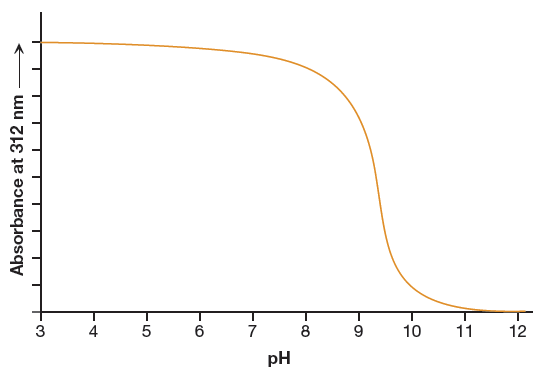In Section 6.2d, we saw that the pK, of an acid is equal to the pH of the solution at which half the acid has dissociated into its conjugate base. UV-vis spectroscopy can be used to measure the relative concentrations involved if the acid or conjugate base absorbs UV-vis light. With this in mind, suppose that a particular acid has a Amax of 312 nm. The figure here shows the absorbance at that wavelength as a function of pH. What is the pk, of the acid? 3 4 6 7 8 10 11 12 pH Absorbance at 312 nm
In Section 6.2d, we saw that the pK, of an acid is equal to the pH of the solution at which half the acid has dissociated into its conjugate base. UV-vis spectroscopy can be used to measure the relative concentrations involved if the acid or conjugate base absorbs UV-vis light. With this in mind, suppose that a particular acid has a Amax of 312 nm. The figure here shows the absorbance at that wavelength as a function of pH. What is the pk, of the acid? 3 4 6 7 8 10 11 12 pH Absorbance at 312 nm
Chemistry
10th Edition
ISBN:9781305957404
Author:Steven S. Zumdahl, Susan A. Zumdahl, Donald J. DeCoste
Publisher:Steven S. Zumdahl, Susan A. Zumdahl, Donald J. DeCoste
Chapter1: Chemical Foundations
Section: Chapter Questions
Problem 1RQ: Define and explain the differences between the following terms. a. law and theory b. theory and...
Related questions
Question

Transcribed Image Text:In Section 6.2d, we saw that the pK, of an acid is
equal to the pH of the solution at which half the acid
has dissociated into its conjugate base. UV-vis
spectroscopy can be used to measure the relative
concentrations involved if the acid or conjugate base
absorbs UV-vis light. With this in mind, suppose that
a particular acid has a Amax of 312 nm. The figure
here shows the absorbance at that wavelength as
a function of pH. What is the pk, of the acid?
3
4
6
7
8
10
11
12
pH
Absorbance at 312 nm
Expert Solution
Step 1
The figure that shows the absorbance at the given wavelength as a function of pH is as shown below:

Step by step
Solved in 2 steps with 2 images

Recommended textbooks for you

Chemistry
Chemistry
ISBN:
9781305957404
Author:
Steven S. Zumdahl, Susan A. Zumdahl, Donald J. DeCoste
Publisher:
Cengage Learning

Chemistry
Chemistry
ISBN:
9781259911156
Author:
Raymond Chang Dr., Jason Overby Professor
Publisher:
McGraw-Hill Education

Principles of Instrumental Analysis
Chemistry
ISBN:
9781305577213
Author:
Douglas A. Skoog, F. James Holler, Stanley R. Crouch
Publisher:
Cengage Learning

Chemistry
Chemistry
ISBN:
9781305957404
Author:
Steven S. Zumdahl, Susan A. Zumdahl, Donald J. DeCoste
Publisher:
Cengage Learning

Chemistry
Chemistry
ISBN:
9781259911156
Author:
Raymond Chang Dr., Jason Overby Professor
Publisher:
McGraw-Hill Education

Principles of Instrumental Analysis
Chemistry
ISBN:
9781305577213
Author:
Douglas A. Skoog, F. James Holler, Stanley R. Crouch
Publisher:
Cengage Learning

Organic Chemistry
Chemistry
ISBN:
9780078021558
Author:
Janice Gorzynski Smith Dr.
Publisher:
McGraw-Hill Education

Chemistry: Principles and Reactions
Chemistry
ISBN:
9781305079373
Author:
William L. Masterton, Cecile N. Hurley
Publisher:
Cengage Learning

Elementary Principles of Chemical Processes, Bind…
Chemistry
ISBN:
9781118431221
Author:
Richard M. Felder, Ronald W. Rousseau, Lisa G. Bullard
Publisher:
WILEY